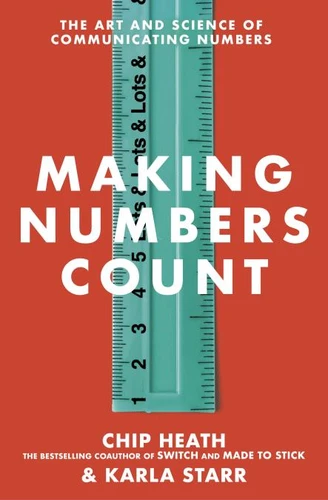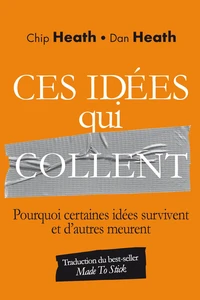Making Numbers Count. The art and science of communicating numbers
Par : ,Formats :
Disponible dans votre compte client Decitre ou Furet du Nord dès validation de votre commande. Le format ePub protégé est :
- Compatible avec une lecture sur My Vivlio (smartphone, tablette, ordinateur)
- Compatible avec une lecture sur liseuses Vivlio
- Pour les liseuses autres que Vivlio, vous devez utiliser le logiciel Adobe Digital Edition. Non compatible avec la lecture sur les liseuses Kindle, Remarkable et Sony
- Non compatible avec un achat hors France métropolitaine
 , qui est-ce ?
, qui est-ce ?Notre partenaire de plateforme de lecture numérique où vous retrouverez l'ensemble de vos ebooks gratuitement
Pour en savoir plus sur nos ebooks, consultez notre aide en ligne ici
- Nombre de pages192
- FormatePub
- ISBN978-1-4735-8532-4
- EAN9781473585324
- Date de parution13/01/2022
- Copier Coller02 page(s) autorisée(s)
- Protection num.Adobe DRM
- Infos supplémentairesepub
- ÉditeurTransworld Digital
Résumé
A lively, practical, first-of-its-kind guide to understanding cold, clinical data and harnessing it to tell a persuasive story.__________How many hours' worth of songs are on your Spotify Wrapped this year?How much is your commute time really worth?How do you work out how likely you are to get Covid based on the official statistics?How do your viewing hours track against the most popular shows on Netflix?Whether you're interested in global problems like climate change, running a business, or just grasping how few people have washed their hands between visiting the bathroom and touching you, this book will help math-lovers and math-haters alike translate the numbers that illuminate our world.
Until very recently, most languages had no words for numbers greater than five - anything from six to infinity was known as 'lots'. While the numbers in our world have become increasingly complex, our brains are stuck in the past. Yet the ability to communicate and understand numbers has never mattered more. How can we more effectively translate numbers and stats - so fundamental to the next big idea - to make data come to life?Drawing on years of research into making ideas stick, Chip Heath and Karla Starr outline six critical principles that will give anyone the tools to communicate numbers with more transparency and meaning.
Using concepts such as simplicity, concreteness and familiarity, they show us how to transform hard numbers into their most engaging form, allowing us to bring more data, more naturally, into decisions in our schools, our workplaces and our society.
Until very recently, most languages had no words for numbers greater than five - anything from six to infinity was known as 'lots'. While the numbers in our world have become increasingly complex, our brains are stuck in the past. Yet the ability to communicate and understand numbers has never mattered more. How can we more effectively translate numbers and stats - so fundamental to the next big idea - to make data come to life?Drawing on years of research into making ideas stick, Chip Heath and Karla Starr outline six critical principles that will give anyone the tools to communicate numbers with more transparency and meaning.
Using concepts such as simplicity, concreteness and familiarity, they show us how to transform hard numbers into their most engaging form, allowing us to bring more data, more naturally, into decisions in our schools, our workplaces and our society.
A lively, practical, first-of-its-kind guide to understanding cold, clinical data and harnessing it to tell a persuasive story.__________How many hours' worth of songs are on your Spotify Wrapped this year?How much is your commute time really worth?How do you work out how likely you are to get Covid based on the official statistics?How do your viewing hours track against the most popular shows on Netflix?Whether you're interested in global problems like climate change, running a business, or just grasping how few people have washed their hands between visiting the bathroom and touching you, this book will help math-lovers and math-haters alike translate the numbers that illuminate our world.
Until very recently, most languages had no words for numbers greater than five - anything from six to infinity was known as 'lots'. While the numbers in our world have become increasingly complex, our brains are stuck in the past. Yet the ability to communicate and understand numbers has never mattered more. How can we more effectively translate numbers and stats - so fundamental to the next big idea - to make data come to life?Drawing on years of research into making ideas stick, Chip Heath and Karla Starr outline six critical principles that will give anyone the tools to communicate numbers with more transparency and meaning.
Using concepts such as simplicity, concreteness and familiarity, they show us how to transform hard numbers into their most engaging form, allowing us to bring more data, more naturally, into decisions in our schools, our workplaces and our society.
Until very recently, most languages had no words for numbers greater than five - anything from six to infinity was known as 'lots'. While the numbers in our world have become increasingly complex, our brains are stuck in the past. Yet the ability to communicate and understand numbers has never mattered more. How can we more effectively translate numbers and stats - so fundamental to the next big idea - to make data come to life?Drawing on years of research into making ideas stick, Chip Heath and Karla Starr outline six critical principles that will give anyone the tools to communicate numbers with more transparency and meaning.
Using concepts such as simplicity, concreteness and familiarity, they show us how to transform hard numbers into their most engaging form, allowing us to bring more data, more naturally, into decisions in our schools, our workplaces and our society.















